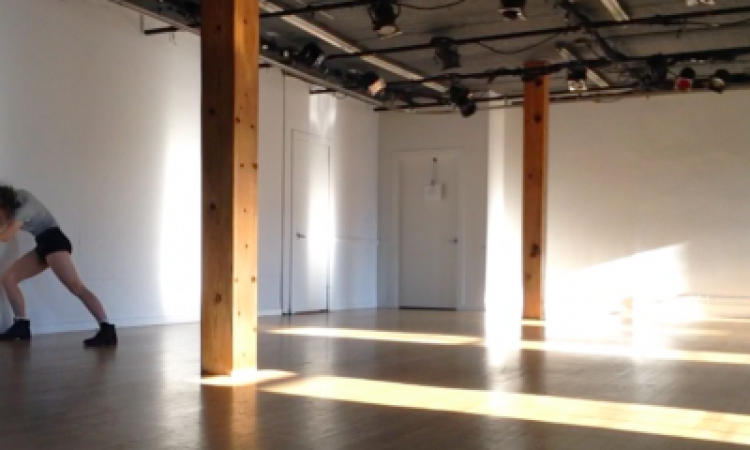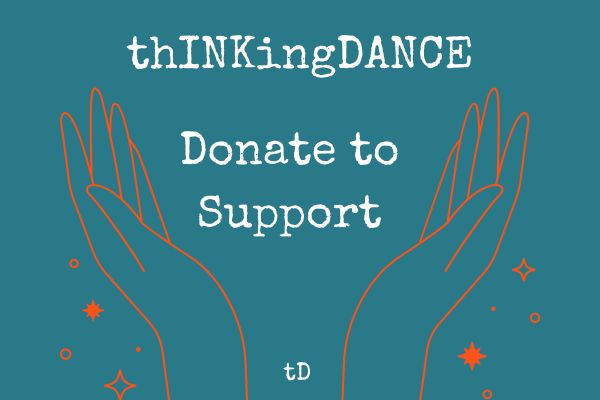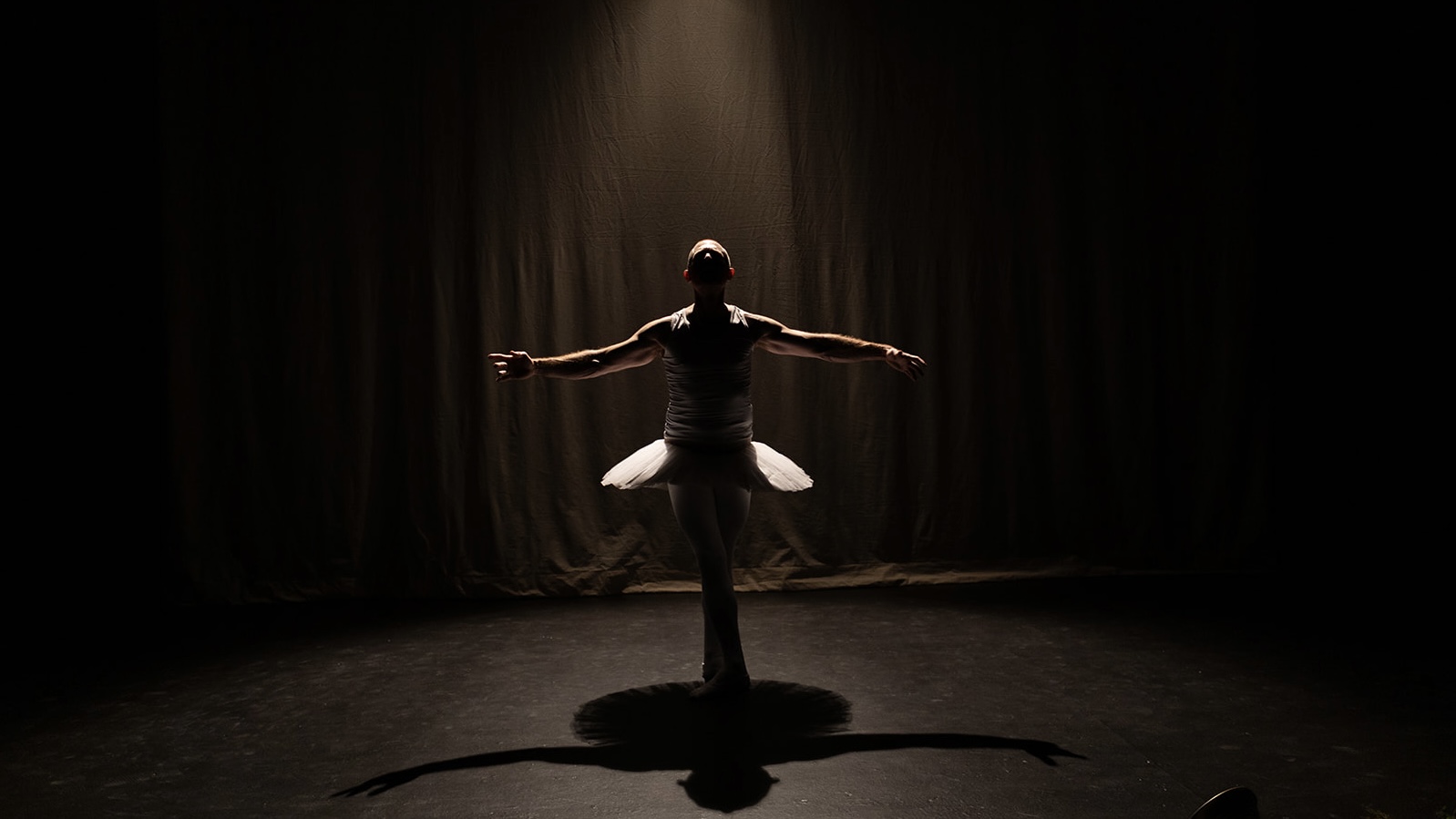In an invitation to her new solo work, Joy Vey, shown at Draftwork at Danspace Project in April, Hadar Ahuvia writes:
I’ve returned to the songs and dances that rooted me in my wandering.
I’ve returned to wrestle with them, with Zionism and its legacy.
I am rewriting and refiguring them to face Nakba*.
I am seeking ancestral healing and liberation for all.
In the program notes of his performance-lecture, Embodied Affiliation and the Politics of Availability, presented at the Knowing Dance More series at University of the Arts in April, Jesse Zaritt explains:
I grew up in a Religious Zionist family in the United States. Although I am no longer religiously observant and do not identify as a Zionist, my affiliation to Jewish Israeli culture is visceral, deeply embodied and profoundly puzzling to me. How is it that my body often betrays my critical, rational and ethical consciousness in the face of criticism and threats to Israel?
These two Jewish-American dance artists are both currently making solo choreographic work that grapples with Zionism, identity, and Palestinian rights. They embody contradictions in their work: How can one celebrate the movement forms that have positively impacted their dancing lives–such as Israeli folk dance or Gaga–while simultaneously confronting the political implications of these forms that have been used by the state of Israel as propaganda tools? Their two independent projects are concurrent, like multiple discoveries that are of this moment and deserve close attention. My own work for justice in Israel and Palestine plus my fascination with these two brave performers compel me to dig deeper into their lives, artistic processes, and differing strategies through this interview.
How does where you’re from and your family’s origins inform your identity and your choreographic work?
Jesse
I was born and raised in Massachusetts. I come from a religious Jewish family with a strong connection to Israel. My parents had lived in Israel for a couple of years before I was born. We have extended family in Israel who we are very close to, whose parents fled from Belarus after WWII.
I recently went to a conference on Jewish arts at UCLA and was part of a Jewish choreographers workshop. The first day the leader of the workshop said: “Let’s all work on Jewish gestures.” Initially that directive really troubled me. I was resistant to creating anything that might be perceived as caricature or stereotype. So I just started moving around and she came up to me and asked: “What are you doing?” I said: “I’m a Jewish body and any gesture I do is a Jewish gesture.”
Jewishness is evident in my choreography because my Jewishness is so deeply embodied. It has always been a part of my life. It has informed my flesh. When I move it’s impossible to not move from that history.
Hadar
I was born in Argentina to a pair of kibbutzniks and grew up in Florida and Israel. I can’t think of a time until young adulthood when I questioned whether Israel was my home. But having this early experience of dislocation gave me a sense of otherness. I also lived in Hawaii for a couple years toward the end of high school which was where I was first made aware of my white privilege through interactions with native Hawaiians.
My grandparents and great-grandparents were victims of anti-Jewish oppression in Europe and became Labor Zionists. They made large sacrifices, leaving their homes, cutting off from their previous cultures, languages, and in some cases family for their ideology and vision of a Jewish life in Palestine. Their conviction for communalism and self-determination inspires me, even as I see that the existential threat they experienced in Europe led them into a colonizing project. I try to hold onto the universalism they aspired to but failed to enact. I hold onto the sense of belonging to the earth, whether it’s Israeli land or not. It was no small thing for Jews to declare that they belonged to the earth, having not been allowed to own land or being evicted from it repeatedly for centuries.
In my work I wrestle with many contradictions by holding on to deeply felt historical connections, acknowledging both real anti-Jewish sentiment that exists in the world, and the state of Israel’s role as an oppressor.
What is your relationship to Zionism? How has it changed over time?
Hadar
I am sometimes a post-Zionist, and sometimes anti-Zionist, and sometimes still a Zionist. What has changed is that I no longer take Zionism for granted, I don’t assume it was inevitable. Sometimes I still think it was necessary, but I wrestle with that.
A high school teacher introduced me to the work of Edward Said and it exposed me to the dehumanization and dispossession of Palestinians. I went into a state of avoidance. I avoided visiting Israel, displaying or connecting to my Jewishness. I’ve since re-invested in Jewish communities of my own choosing, opened myself to Jewish experiences of the diaspora, but also reclaimed love for my heritage. So I question Zionism from a place of love and sorrow, for my people and family and culture, for Jewishness. I believe that standing with Israelis and Palestinians is not an inherent contradiction and that facing the Palestinian Nakba is an existential necessity.
Jesse
I grew up in a very Zionist environment where I fantasized about Israel as a place of redemption, a place where all the ways in which Jewishness was embarrassing to me were transformed to reflect pride and belonging. A dominant narrative in my childhood was that Israeli men were powerful and strong, as opposed to the stereotype of the bookish, weak Jewish male.
In college I studied abroad at Tel Aviv University and a broader political perspective was revealed to me. I took a course on Arab history in the Middle East. Learning through the lens of Arab experience rewrote the narrative for me. I traveled to Jordan and spent some time there. I moved from the American dorm to new living quarters with local students. There were a lot of Russian immigrants and also some Palestinian students. There I experienced a lot of cultural exchange. I tutored two Palestinian students in English. I was exposed to more narratives. The perspectives started to multiply.
How has or would your family respond to your choreographic work?
Jesse
My family is also engaged in a shifting relationship to Israel to varying degrees. We all have very close relationships to friends, family and colleagues there. My family is receptive to new ideas because they are inside the question of how we negotiate loving the people who we love and the things in Israel that we cherish while also not being blinded by the negative impact that this conflict is having on Palestinian and Israeli lives.
Hadar
In earlier versions of my work I imagined my parents, siblings, and cousins in Israel as my audience. It was more opaque, signaling a sense of sadness, betrayal and loss that might not necessarily be read as politicized. As I’ve become more legible in my stance there is a danger of losing my family. One aunt has cut contact with me after I posted something on Facebook.
How has Israeli dance informed your movement and choreography, whether it be Gaga or folkloric dance or another form?
Hadar
I practiced Israeli folk dance with my mom in Florida and Hawaii. It was a way to maintain our identity abroad. We performed at an Israeli Independence day event in Hawaii which was being picketed by pro-Palestinians and native Hawaiians. I didn’t yet understand the connection between native struggles against colonialism, because I didn’t see the Israeli/Palestinian conflict that way.
When I began to question Zionism I rejected Israeli folk dance. I didn’t do folk dance after that for a while, but I kept singing the songs to myself.
Israeli folk dance performs nationality internally and externally. My mom created and performed dances on the kibbutz, toured with Israeli folk dance groups, was sent to teach in Europe and America, as were many folk dance troupes, to represent the fledgling state.
Israeli folk dance, by which I mean the tradition begun by European Jewish women in Palestine (some who were students of modern dance in Germany) and dominated by Ashkenazi Jews, is bouncy and less grounded than Yemenite dancing in Israel, or Arab dabkes. I have re-cultivated that bounciness and re-embraced the dances on my terms. Despite ideological shortfalls of Israeli folk dance, it is life affirming to dance in a circle, in synchronicity and joy with others. I reclaim this.
Jesse
Gaga as a practice is about experiencing availability and trying to release tension, habit, rigidity and opening up one’s body to a multiplicity of experiences and sensations. That was so liberating for me. I started to wonder, what if I could use this practice to question or un-fix my body from its deepest affiliations? Is there something in this practice that can help me detach from the knee jerk, defensive reaction that I have to any kind of criticism of Israel? I acknowledge that so much of my visceral connection to Israel is a part of the way I was brought up, things that I learned, my conditioning. On the other hand, I feel a kind of shame. I don’t always want people to know about my connection to a country that has committed such intensely aggressive and brutal actions. Both of these reactions (defensiveness and shame) are acting on my flesh. Can Gaga’s insistence on availability help me see past these two blinding/binding reactions?
I want Gaga to circulate as a set of tools that helps dancers expand their sense of themselves as movers. But I also understand that the State of Israel has a history of using art and artists as tools to showcase Israel’s creative excellence. The Gaga technique was not made with the intent to be a tool of propaganda. I can critique the frame that the State may place on Gaga–and other Israeli dance companies and practices/practitioners–without rejecting the work that they are doing.
How are your politics and dance practice in conversation with one another?
Jesse
One of the ways that some people defend Israel is by saying: “it’s really complicated,” as if the complexity is a way of saying it’s too much to address. At the end of the day some aspects of it are not complex. They are quite stark and brutal. Look at a home demolition, a terror attack, or the blockade of goods to Gaza. You could talk about how complex it is, but there are people in Gaza without adequate resources and that’s not complex. Who is dying and who is living?
The reason why I keep engaging with this issue is that it’s very real in my body. When I’m confronting my body in my practice as an embodied artist, this is what keeps coming up. This is the war inside my body, so I can’t ignore it.
My dancing is full of questions. I give myself permission to be confused. I thank dance for being the place where I can let my body ride along all the different vectors that each question brings up. Each question shoots through my body in a different energetic line. I’m simultaneously confused and broken and hopeful and connected and alienated… it all gets to be there at once and overlapping. And this feels necessary for me.
Hadar
Joy Vey is an attempt to refigure these nationalist dances to face Nakba, either by remaking the songs Israelis dance to, or breaking the lightness and carelessness of them. I bring into them the contradictions. The violence Zionism brought to Palestinians also hurt the Israeli Jews who became militant oppressors. I try to expose that.
Israeli folk dancing is one embodiment of my family history, a tradition like language that directly links me to my mother. It is a history I am deeply connected to and also critical of. I use language, the voice in Hebrew and English to embody the tension of joy, loss, denial, and anger. I don’t know if I’m doing it successfully, but I do know that it makes more sense to live and embody the contradiction than to try and eliminate one aspect of it from my being.
Have you worked with Palestinians before, or if not what are the challenges/obstacles?
Hadar
I have not collaborated with Palestinians. I recognize I need to have Palestinians and Jews of color check my perspective. This is not to alleviate myself from responsibility and doing my own work to tackle internalized racism, but because there are things I don’t see. I also want to make sure that I’m not seeking approval and asking Palestinians to affirm the work I’m doing. I began to do this work for myself, for my own processing. The work is beginning to expand beyond that. I know of a few collaborations between Israelis and Palestinians but haven’t seen the actual productions. I wonder about the challenges of collaborations in light of the call for non-normalization of relationships with Israeli institutions.
Jesse
I’ve been to the West Bank a few times and I initiated a conversation with the Palestinian dance company El-Funoun. The meeting didn’t work out logistically. This particular work I’m doing now, Embodied Affiliation and the Politics of Availability, is very much about a Jewish American dialogue with Israel.
How do you see these issues that you grapple with in your choreography playing out in your teaching?
Jesse
Dance is powerful because it is a site where we can touch things that can’t be named. In my teaching I’m committed to enabling dance artists to access not just more physical capacity, but also a more engaged critical discourse with the way their bodies function in the world. I think dance training has to include critical thinking and critical action with our bodies. We’re training ourselves to be virtuosic technicians, virtuosic intellectuals and virtuosic perceivers.
I recently traveled to Israel/Palestine with a group of students. One of the great things that happened–as we were dancing, learning, performing, taking a tour throughout East Jerusalem, looking at the conflict from the perspective of Palestinians living there, and staying in Israeli homes in West Jerusalem–was that one student said to me: “Just tell me what to think.” My response was “No. Chew on all of this. Figure out where and how you’re going to position yourself.”
Hadar
I am teaching a course to my middle school students at Kolot Chayeini, a progressive Jewish synagogue in Brooklyn, about the formation of Israeli national identity through dance, the sources Israelis appropriated/borrowed/rejected, the narratives it reinforces, the aspirations it expresses. We will be dancing Israeli folk dances, and investigating how they sourced Yemenite dances and Palestinian dabke. I hope through this process students will gain an understanding of the asymmetrical power dynamics at play, the complexity of Israeli identity. I am excited that we will be dancing, and have an embodied experience. I think this creates space for processing Israel/Palestine with the intelligence of our whole body, our best empathic tool.
Who are the audiences for your work?
Jesse
The impact Embodied Affiliation and the Politics of Availability had on students at UArts is in line with my teaching. The kinds of questions I’m asking them lives in my work: What does dance do besides perform itself? How is it a tool we can use to confront the ethics of being in the world? It sparked a new way for a few Jewish Uarts students to look at their identity. At Hollins University I showed the piece to some graduate students of many different backgrounds. They shared with me their own journeys through identity, national belonging and struggles with affiliation, which was gratifying.
Can you speak more about any political affiliations you have?
Hadar
I am a founding member of the Jewish Voice for Peace (JVP) Artist and Cultural Workers Council. It has been a challenge and exhilarating. As an Israeli-American on the Council, I see my role in sharing my understanding of anti-Jewish oppression, and ensuring that members don’t forget that JVP calls for a stand in solidarity with Palestinians and Israelis against the occupation. I applied to become part of the council because I wanted to be connected to artists doing this work and get support doing it. I’ve received that and more. The relationships I have built have been incredibly meaningful. I don’t always agree with JVP or members of the council, but they have given me the courage to challenge myself, to learn, and to risk personal loss.
Hadar Ahuvia, Draftwork at Danspace Project, April 25; Jesse Zaritt, Knowing Dance More Lecture Series, University of the Arts, April 8.
*All links that define terms were chosen by the author, with permission by the interviewees, but do not necessarily reflect their opinions.






